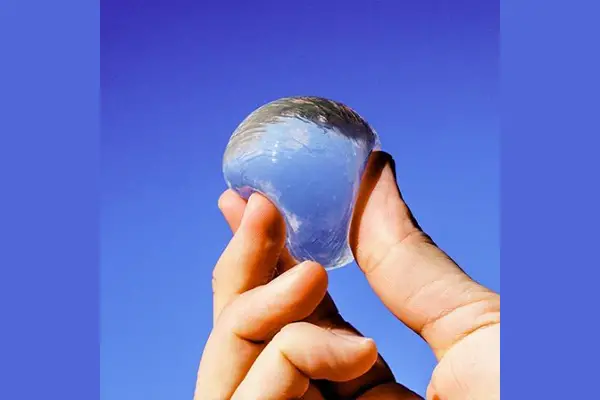
Image source: https://twitter.com/oohowater
In America alone, people dispose of 2.5 million plastic bottles every hour. At the same time only 10% of households have a recycling program, and just 63% of all communities have access to a recycling center for plastic. It is estimated that 80% of all plastic bottles wind up in landfills. Because plastic may take up to 1000 years to decompose, every piece of plastic you ever used is still out there today. Approximately 100 million tons of it are in the ocean, threatening the wild life.
It is becoming vital that we find another way to package our products. A London-based company may have one answer to the problem. Skipping Rocks Lab has recently won an EU Sustainability Award for creating Ooho! – a biodegradable and edible packaging for water.
“The aim of Ooho is to provide the convenience of plastic bottles while limiting the environmental impact,” wrote the creators.
Made from seaweed, it is an unconventional substitute for a plastic bottle. What looks like a big bubble filled with drinking water is single-use, and it is cheap to produce. To drink the water, you need to pop the bubble using your teeth to acess the water inside. The bubble that is left after drinking can be thrown away to biodegrade or can be eaten, according to OohoWater.com
“At the end of the day you don’t have to eat it. But the edible part shows how natural it is. People are really enthusiastic about the fact that you can create a material for packaging matter that is so harmless that you can eat it,” told Ooho designer Pierre Paslier to The Guardian.
Ooho packaging is not available to the public yet, and the EU award’s grand money may help bring it to the mainstream.
Creating Your Own Edible Water
An instructional video on YouTube shows step-by-step how to create Ooho-like packaging in your own home. All you need is water, sodium alginate and calcium lactate (both used in nutritional supplements). Neither seem to have any negative effect if ingested unless consumed in extremely large amounts (too much sodium or calcium has side-effects for some people). Sodium alginate is often used in weight loss diets and is made from seaweed. Calcium lactate is often used for calcium deficiency (although it is also wise to use a quality magnesium supplement if taking calcium in order to balance the two). Both can be bought online.
Would you try this edible water? Take a closer look in the video below.
Thanks for installing the Bottom of every post plugin by Corey Salzano. Contact me if you need custom WordPress plugins or website design.




